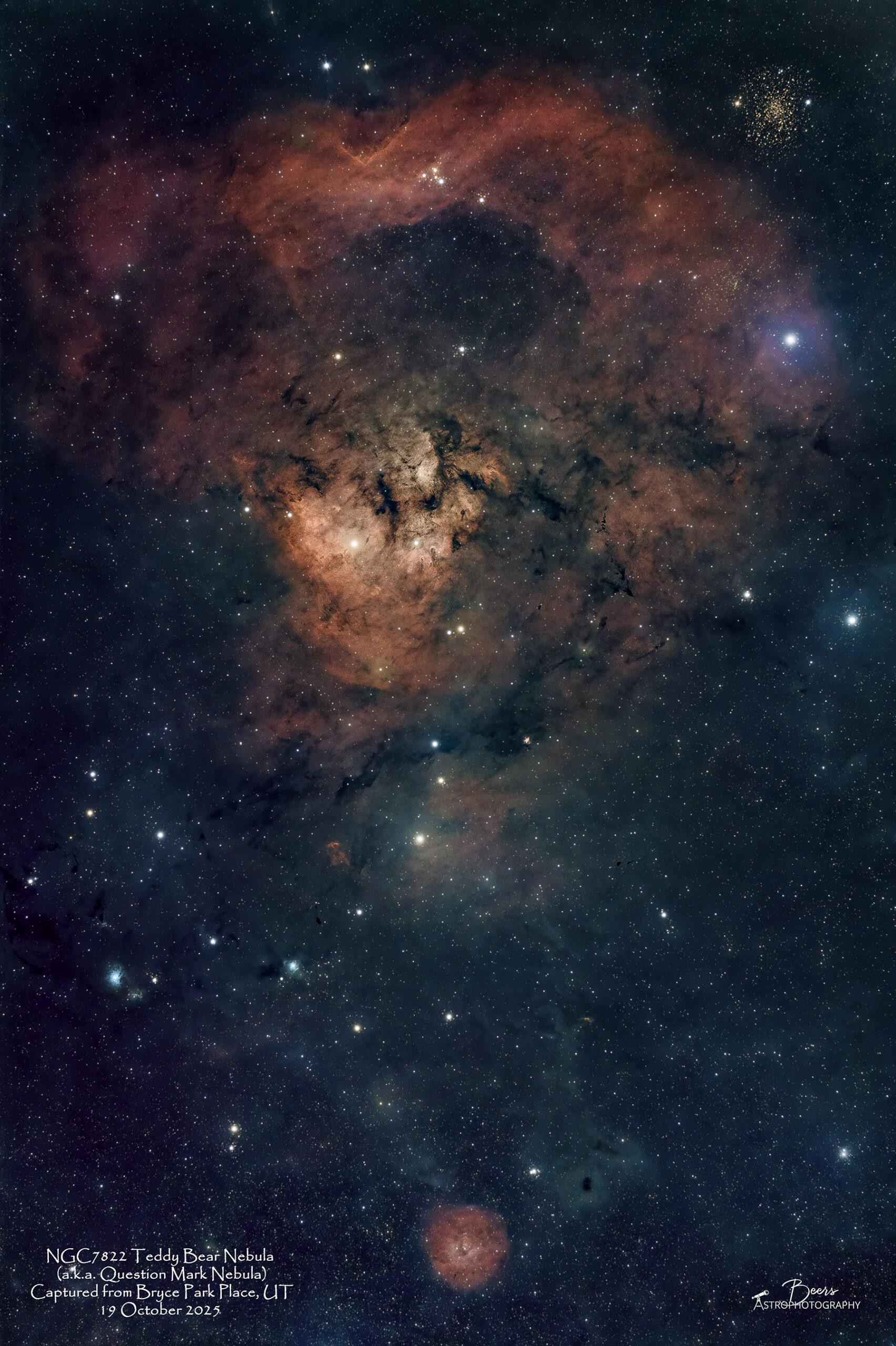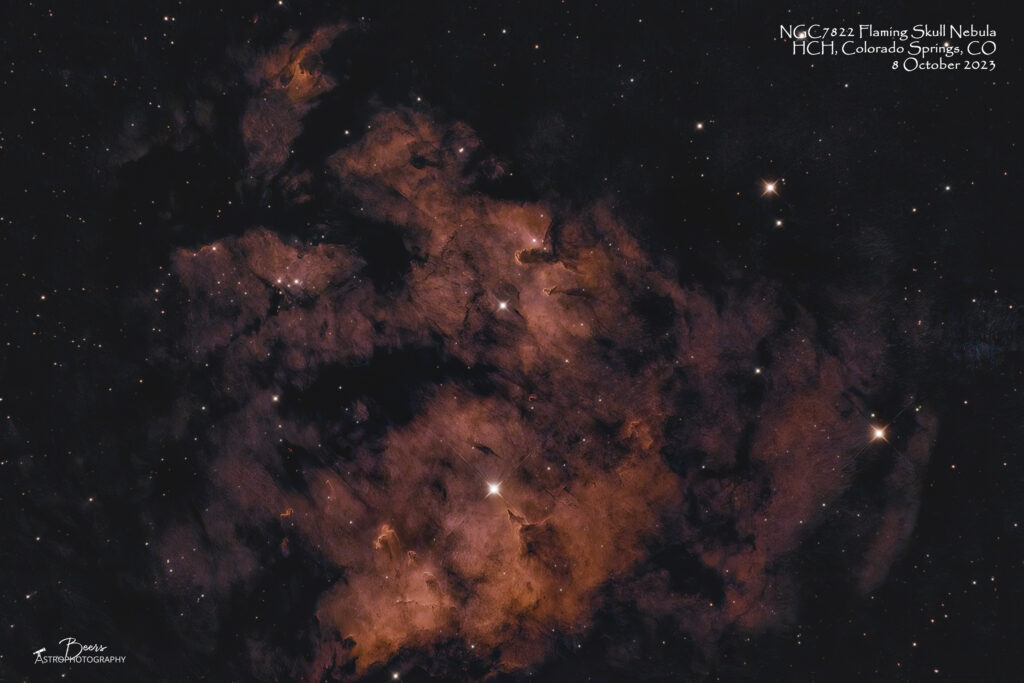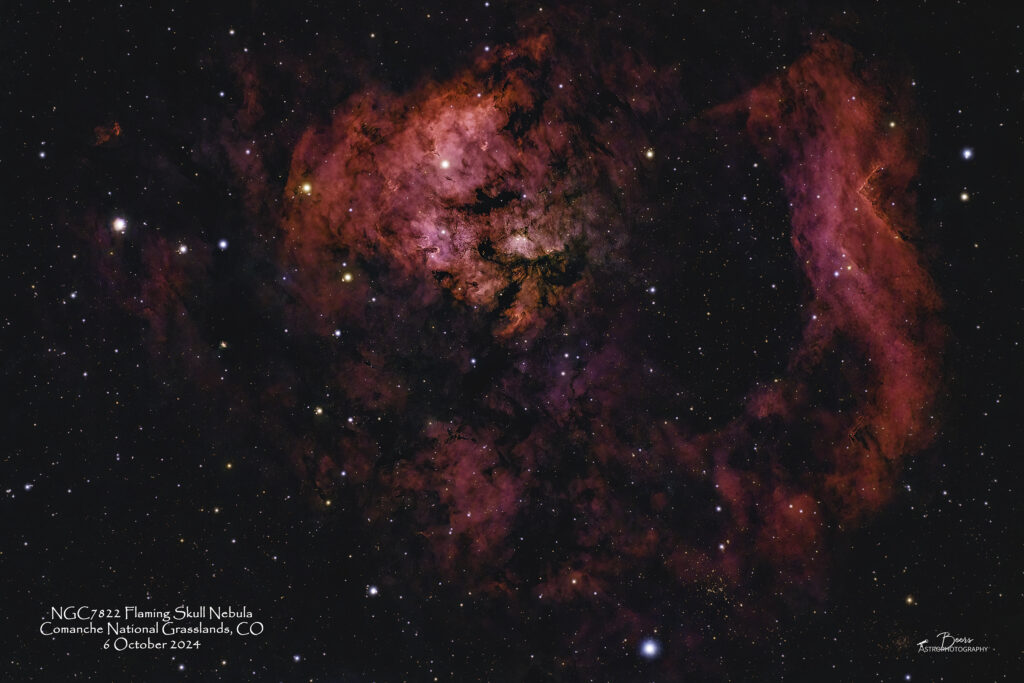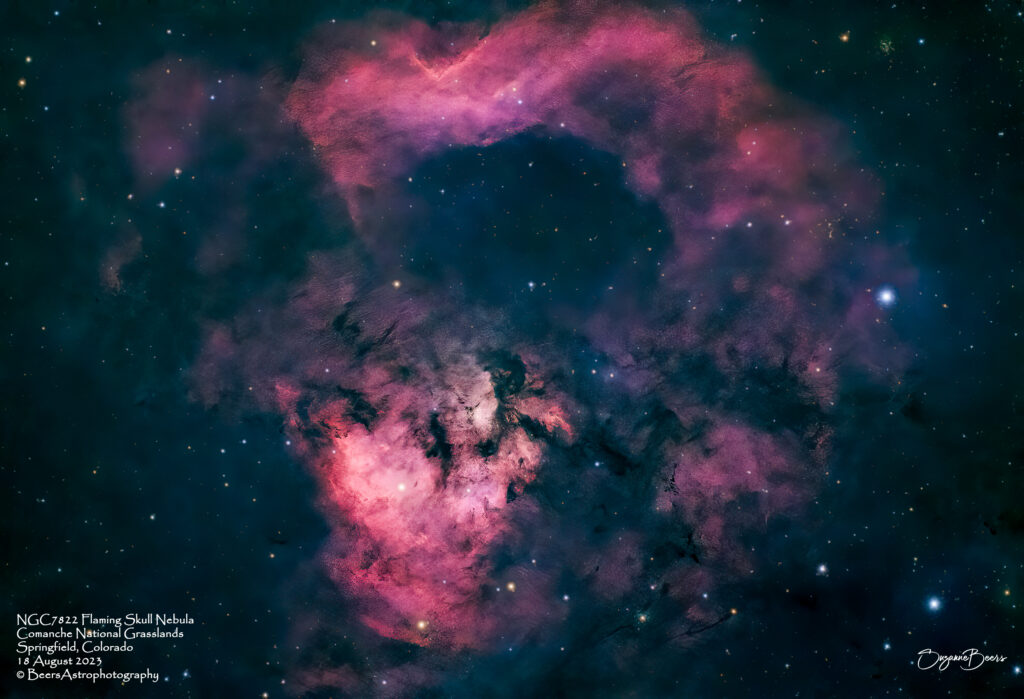
NGC7822 Teddy Bear Nebula (a.k.a. Question Mark Nebula, previously known as Flaming Skull Nebula); captured from Bryce Park Place, Cannonville, Utah using the Southern Cross with its 0.7x reducer on 19 October 2025
Target Fun Facts
NGC 7822 is a young star forming complex in the constellation of Cepheus. The complex encompasses the emission region designated Sharpless 171, and the young cluster of stars named Berkeley 59. The complex is believed to be 2900 light years away, with the younger components aged no more than a few million years. The complex also includes one of the hottest stars discovered within 1 kpc of the Sun, namely BD+66 1673, which is an eclipsing binary system consisting of an O5V that exhibits a surface temperature of nearly 45,000 K and a luminosity about 100,000 times that of the Sun. The star is one of the primary sources illuminating the nebula.
Other Designations: SH2-171, LBN589, Ced215
Formal Names: Teddy Bear Nebula, Question Mark Nebula, Flaming Skull Nebula
Subtype: HIII region
Distance from Earth: 2609 light years
Size: 75 light years (radius)
Size (apparent dimensions): 1°40’
Constellation: Cepheus
{ From: https://en.wikipedia.org/wiki/NGC_7822 and Stellarium }
BeersAP Editorial Comment: Name Change? During previous planning and imaging of NGC7822, when it had a name it was always the Flaming Skull Nebula…and I’d finally “seen” the skull in the image (especially in the image I captured from the Comanche National Grasslands in October 2024 – see below under previously captured images in dark skies). When I started planning for this trip, all the sources I use to correlate catalogue number with name seemed to have changed the name from Flaming Skull Nebula to Teddy Bear Nebula or Question Mark Nebula… I’m definitely seeing the Question Mark with the Southern Cross’ 0.7x Reducer expanded field of view (420mm), but I’m having a harder time seeing the Teddy Bear in the image. A little off-topic science for you, perhaps the reason I’m not seeing a teddy bear: The term for remembering the first thing you see in an image is the primacy effect. It is a cognitive bias in which the first piece of information encountered is recalled more easily and given more weight than subsequent information.
Here is a recent description from Astrobin – (https://app.astrobin.com/i/d1e63a):
Sharpless 2-171, nestled within the expansive NGC 7822 nebula located in the constellation of Cepheus, stands as a captivating emission nebula distinguished by its distinctive elephant trunk-like structures sculpted by the powerful stellar winds emanating from the hot, luminous stars at its core. NGC 7762 along with NGC 7822 have been referred to collectively as the “Cosmic Question Mark” although my capture isn’t wide enough to reveal that full structure. I think the Teddy Bear Nebula can stand on its own. Despite its recognized features, this nebula presents a whimsical appearance akin to a teddy bear gazing directly at us from the depths of space. Imaginatively, the nebula’s two brightest stars manifest as its sparkling eyes, complemented by the illusion of large, circular red ears, a notable brown nose, and an unmistakable inverted V-shaped mouth line. This cosmic spectacle not only showcases the intricate beauty of celestial formations but also offers a playful and enchanting perspective on the wonders of the universe.
Equipment
All equipment controlled by HP Probook running Sequence Generator Pro v4.4.1.1441.
- Imaging (ASI2400-SC with 0.7x Reducer): ZWO ASI2400MC imaging camera; (Southern Cross) Askar FRA600 108mm f/5.6 Quintuplet Petzval Flat-Field Astrograph with Askar 0.7x Reducer for Askar FRA600 108mm Astrograph
- Autofocuser: ZWO EAF Electronic Automatic Focuser (EAF-5V-STD)
- Mount: Rainbow Astro RST-135E (controlled by iHubo ASCOM driver)
- Polar alignment: QHYCCD camera (controlled by Polemaster for polar alignment)
- Autoguiding: Orion 60mm Multi-Use Guide Scope with Orion StarShoot AutoGuider Pro Mono Astrophotography Camera (controlled by PHD2)
Capture & processing notes
This was the first target on our first night at Bryce Park Place during my 65th birthday dark skies trip to Utah. I had to pause for a few minutes as darkness was descending because there were quite a few clouds in the area. At about 19:45, it was clear to the north so I started my polar alignment process. By the time I finished that (which didn’t take very long at all, perhaps a total of 15 minutes), the skies were clear so I disconnected the PoleMaster and connected all my imaging equipment’s power and control cables. I kicked off the session to a very dark SGP autofocus routine – it took me a few seconds to realize (well into the second or third AF image capture) that I’d forgotten to take off the lens cap on the telescope and autoguide camera! Amazing what the focuser does when it actually has stars to focus on!!
Since the focuser position was a guess when I was setting up the gear, I had to do a bit of manual focusing before I could let SGP take it away. I also checked the autoguider camera focus while I was at it…the camera was in focus, but seemed to be having a hard time picking up stars in its field of view (?). It only selected three stars and the autoguiding was pretty rough for the first portion of the night until I came back out (at 23:36MDT) to execute the meridian flip.
The sequence kicked off by collecting its first subframe starting at 20:37 – not bad, 15 minutes from “take the lens cap off, dummy” to first collect!
I executed the meridian flip at 23:45MDT by ending the sequence, powering down all the software, cycling power on the mount, disconnecting/reconnecting the autoguider camera’s cable, then restarting the sequence. The autoguider found more stars and its calibration was much better. The post-meridian flip collection started at 23:54MDT and continued until I ended the sequence at astronomical twilight at 20Oct2025, 06:27MDT; capturing 105x5min subframes for a total of 8:45hrs of data.
Sequence Plan (19Oct2025): Gain 158, Offset 30, Temp 0°C; 105x5min. Captured 19Oct2025, 20:37MDT – 20Oct2025, 06:27MDT. Total imaging time: 525 minutes; 8:45 hours
Processing: Captured in SGP, stacked in APP (Adaptive Airy Disc), star removal with Starnet++, processing with LR/PS (using my adaption of Bill Banshan’s star removal technique).
Summary
Sequence Plan (19Oct2025): Gain 158, Offset 30, Temp 0°C; 105x5min. Captured 19Oct2025, 20:37MDT – 20Oct2025, 06:27MDT. Total imaging time: 525 minutes; 8:45 hours
Shooting location: Bryce Park Place, Cannonville, Utah
Equipment: Southern Cross with 0.7x Reducer
Processing: Captured in SGP, stacked in APP (Adaptive Airy Disc), star removal with Starnet++, processing with LR/PS (using my adaption of Bill Banshan’s star removal technique)
Previously captured images of NGC7822, then the Flaming Skull Nebula
Captured from the city lights of HCH

Capture & processing notes
Capture Notes: This was the second object captured on Sunday night, 8 October 2023 during a streak of clear nights leading up to our departure on Thursday (12Oct2023) to image the annular solar eclipse. Since, I’d recently (the day before!) figured out the field flattener and we were only going to take the Southern Cross to Los Alamos, I decided to spend my time imaging from the front patio as much as possible with Big Bertha, the field flattener, and light pollution filters.
Sequence plan: Gain: 158, Temp: -0°C, offset=30; 59x5min; Total exposure time: 4:55hrs. Captured 8 October 2023 (9Oct23, 0108 – 0613MDT).
Processing: Captured in SGP, stacked in APP, star removal with Starnet++, processing with LR/PS
Equipment
All equipment controlled by HP Probook (DSO CTRL 2) Windows 11 laptop running SGP v4.2.0.16.
- Polar alignment: QHYCCD camera (controlled by Polemaster)
- Imaging: (Big Bertha) Orion 8″ f/8 Ritchey-Chretien Astrograph Telescope, ZWO ASI2400MC imaging camera, Teleskop Services TS-Optics 2″ 1.0x Flattener and Field Corrector for Ritchey-Chrétien Telescopes (TS-RCFLAT2), 89.7mm of connector tubes between camera and TS-RCFLAT2 for proper backfocus (M54M-M48F 21L, 2” M48F, M48F 16.5L), Optolong LeXtreme light pollution filter
- Mount: SkyWatcher EQ6‑R PRO Synscan mount (controlled by ASCOM driver)
- Autoguiding: Orion 60mm Multi-Use Guide Scope with Orion StarShoot AutoGuider Pro Mono Astrophotography Camera (controlled by PHD2)
Summary
Sequence plan: Gain: 158, Temp: -0°C, offset=30; 59x5min; Total exposure time: 4:55hrs.
Capture: Captured night of 8 October 2023 (9Oct23, 0108 – 0613MDT).
Shooting location: HCH, Colorado Springs, CO
Processing: Captured in SGP, stacked in APP, star removal with Starnet++, processing with LR/PS
Captured from dark skies

Equipment
All equipment controlled by HP Probook running Sequence Generator Pro v4.4.1.1441.
- Imaging (ASI2400-SC): ZWO ASI2400MC imaging camera on (Southern Cross) Askar FRA600 108mm f/5.6 Quintuplet Petzval Flat-Field Astrograph
- Autofocuser: ZWO EAF Electronic Automatic Focuser (EAF-5V-STD)
- Mount: Rainbow Astro RST-135E (controlled by iHubo ASCOM driver)
- Polar alignment: QHYCCD camera (controlled by Polemaster for polar alignment)
- Autoguiding: Orion 60mm Multi-Use Guide Scope with Orion StarShoot AutoGuider Pro Mono Astrophotography Camera (controlled by PHD2)
Capture & processing notes
NGC7822 Flaming Skull was the second target for the Southern Cross on our second night at the Comanche National Grasslands Camel Rock camping site during our October dark skies trip.
I didn’t need to reorient the camera, thus no capturing of light frames was required in-between targets since both were captured at a 90° orientation. So, the target switch took an amazingly quick 15 minutes (00:27 – 00:45MDT). The data collection went flawlessly (with great autoguiding performance) throughout the night until I terminated the sequence at astronomical twilight.
Sequence Plan (5Oct2024): Gain: 158, Temp: -0°C, offset=30. 56x300sec. Total: 280 minutes (4:40 hours). Captured 7Oct2024, 00:45MDT – 7Oct2024, 05:53MDT.
Processing: Captured in SGP, stacked in APP (Adaptive Airy Disc), star removal with Starnet++, processing with LR/PS
Summary
Sequence Plan (5Oct2024): Gain: 158, Temp: -0°C, offset=30. 56x300sec. Total: 280 minutes (4:40 hours). Captured 7Oct2024, 00:45MDT – 7Oct2024, 05:53MDT.
Shooting location: Comanche National Grasslands’ Camel Rock, Colorado
Equipment: Southern Cross
Processing: Captured in SGP, stacked in APP (Adaptive Airy Disc), star removal with Starnet++, processing with LR/PS

Equipment
Polar alignment: QHYCCD camera (controlled by Polemaster)
Imaging stream: (Southern Cross) Askar FRA600 on Rainbow Astro RC-135E, ZWO ASI2400MC camera
Mount: Rainbow Astro RC-135E (controlled by iHubo ASCOM driver)
Autoguider: None (accidently left at home!)
All equipment controlled by HP Probook running Sequence Generator Pro v3.2.0.660.
Capture & processing notes
Capture Notes: This was the second target of the night, captured from Springfield, Colorado. Specifically, from Comanche National Grasslands public land on a spot about half a mile south of US Hwy 160 off County Road 24.3. The trip was a hybrid dark skies (staying in a hotel in Springfield because of the 100 degree heat) and an anniversary trip to Albuquerque for dinner at dinner at Sal’s. We took the Expedition and in packing my gear, I decided to take only one guide scope to save space in the Pelican case optics box for my Milky Way lens and camera. Of course, in doing that, I took out the guide scope that has the attachment mount to the Southern Cross. So, the imaging was done throughout the night without a guide scope. The other change from “routine” is I’d read about 2×2 binning and how it can essentially increase the sensitivity and allow decreased exposure time. The capture seemed to go well (with no guide scope, there were no lost guide stars to terminate the sequence), but when I got home to begin the APP stacking process I struggled mightily. During the registration process, the process would fail – it would show one subframe that was the culprit, but when that file was deleted it still wouldn’t complete the registration step. I deleted the bad subframe and the two initial subframes that we captured with 3-minute exposures, then selected to stack the top 50 subframes (the process was failing after 52) and that finally produced a result out of APP. So, although I captured 86 x 2minute exposures (3:54hrs), the final stack only contained 50/83 (1:45hrs).
Summary
Sequence plan: Gain: 300, Temp: 0°C, offset=NotSet, Bin: 2×2. 86x2min. Captured 19Aug2023, 0125MDT – 0429MDT. Total exposure time: 2:52hrs.
Capture: 19 August 2023, 0125MDT – 0429MDT. Total exposure time: 2:52hrs (Culled during registration in APP to 50/83, image is 50x2min. Total time in image: 1:40hrs.
Shooting location: CR24.3 Springfield Colorado; Comanche National Grasslands
Processing: Stacked in APP, processed in LR/PS.
